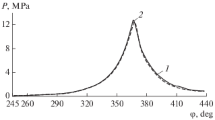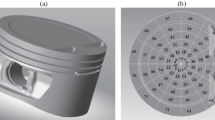Abstract
This paper presents a macrokinetics-based mathematical model for the numerical simulation of the fuel self-ignition period in a local volume of a hydrogen diesel engine with high pressure fuel injection equipment. A detailed kinetic mechanism of hydrogen oxidation with a special software were used to simulate hydrogen self-ignition in homogeneous chemical reactors for operating conditions of a real hydrogen diesel engine at the moment of the start of hydrogen gas injection. From the results of these simulations for constant-volume and constant-pressure reactors, an equation for the macrokinetics of hydrogen oxidation at high pressures was derived. Using this equation, various operation modes of a hydrogen diesel engine with heating of air and hydrogen were investigated by numerical methods. Ways to reduce the induction period and increase the engine reliability are indicated.





Similar content being viewed by others
REFERENCES
R. Z. Kavtaradze, “Hydrogen Diesel—Engine of the Future," in Proc. 7th Russian National Conference on Heat Transfer, October 22–26, 2018, Moscow (MPEI, Moscow, 2018), pp. 15–19.
O. M. Todes, “Adiabatic Thermal Explosion," Zh. Fiz. Khim. 4 (1), 71–75 (1933).
O. M. Todes, “Theory of Thermal Explosion. I. Thermal Explosion of Zero-Order Reactions," Zh. Fiz. Khim. 13 (7), 868–879 (1939).
P. K. Senachin and V. S. Babkin, “Auto-Ignition of Gas in Front of the Flame Front in a Closed Vessel," Fiz. Goreniya Vzryva 18 (1), 3–8 (1982) [Combust. Expl. Shock Waves 18, 1–5 (1982); https://doi.org/10.1007/BF00783921].
P. K. Senachin, R. Kh. Abdullin, and V. S. Babkin, “Analysis of Ignition in a Diesel Engine," in Combustion Physics and Its Research Methods (Chuvash State University, Cheboksary, 1983), pp. 50–53.
D. D. Matievskii and P. K. Senachin, “Delay in the Ignition of Fuels in a Diesel Engine as an Induction Period of a Dynamic Thermal Explosion," Izv. Vyssh. Uchebn. Zaved., Mashinostroenie, No. 4–6, 27–32 (1995).
P. K. Senachin, D. D. Matievskii, and A. P. Senachin, “Modeling of Fuel Ignition Delay in a Diesel Engine," Vestn. Altaisk. Gos. Tekh. Univ. im. I. I. Polzunova, No. 3, 64–68 (2001).
A. N. Voinov and V. Janardhana Chetty, “Analysis of Diesel Engine Ignition Taking into Account the Influence of Chemical-Kinetic and Physical Factors," Izv. Vyssh. Uchebn. Zaved., Mashinostroenie, No. 4, 77–81 (1970).
G. M. Kamfer, “Calculation of the Ignition of Atomized Fuel," Izv. Vyssh. Uchebn. Zaved. Mashinostroenie, No. 3, 98–102 (1976).
V. I. Odintsov, “Method for Calculating the Fuel Ignition Delay Taking into Account the Influence of Design Factors," Dvigatelestroenie, No. 3, 17–18 (1990).
U. Pfahl, K. Fieweger, and G. Adomeit, “Auto-Ignition of Diesel-Relevant Hydrocarbon–Air Mixtures under Engine Conditions," Symp. (Int.) on Combust. 26 (1), 781–789 (1996); DOI: 10.1016/S0082-0784(96)80287-6.
N. Septivany and B. W. Riyandwita, “Spark Ignition Engine Modeling for In-Cylinder Pressure and Temperature Prediction Using Simulink," MATEC Web Conf. 204, 04001 (2018); DOI: 10.1051/matecconf/201820404001.
A. P. Senachin, A. A. Korzhavin, and P. K. Senachin, “Determination of the Global Kinetics of Diesel Fuel by Numerical Solution of the Inverse Problem of Self-Ignition Dynamics in a Diesel Engine," Polzunov Vestn., No. 4, 155–165 (2009).
P. K. Senachin and A. P. Senachin, “Fuel Ignition Delay in a Diesel Engine with a High-Pressure Fuel Supply System," Izv. Samar. Nauch. Ts. RAN 13 [1(2)], 479–486 (2011).
A. P. Senachin, A. A. Korzhavin, and P. K. Senachin, “Simulation of Fuel Ignition Delay in Diesel Engines with Various Fuel Feeding Systems," Procedia Eng. 150, 190–203 (2016); DOI: 10.1016/j.proeng.2016.06.746.
B. A. Mirtov, The Gas Composition of the Earth’s Atmosphere and Methods of Its Analysis (USSR Acad. of Sci., Moscow, 1961) [in Russian].
E. S. Shchetinkov, Physics of Gas Combustion (Nauka, Moscow, 1965) [in Russian].
J. Warnatz, U. Maas, and R. W. Dibble, Combustion. Physical and Chemical Fundamentals, Modeling and Simulation, Experiments, Pollutant Formation (Fizmatlit, Moscow, 2003; Springer-Verlag, Germany, 2006).
M. O. Conaire, H. J. Curran, J. M. Simmie, W. J. Pitz, and Ch. K. Westbrook, “A Comprehensive Modeling Study of Hydrogen Oxidation," Int. J. Chem. Kinet. 36 (11), 603–622 (2004); DOI: 10.1002/kin.20036.
P. Boivin, A. L. Sánchez, and F. A. Williams, “Four-Step and Three-Step Systematically Reduced Chemistry for Wide-Range H2–Air Combustion Problems," Combust. Flame 160 (1), 76–82 (2013); DOI: 10.1016/j.combustflame.2012.09.014.
A. L. Sánchez and F. A. Williams, “Recent Advances in Understanding of Flammability Characteristics of Hydrogen," Prog. Energy Combust. Sci. 41, 1–55 (2014); DOI: 10.1016/j.pecs.2013.10.002.
V. I. Dimitrov, In Simple Kinetics, Ed. By R. I. Soloukhin (Nauka, Novosibirsk, 1982) [in Russian].
I. Glassman and R. A. Yetter, Combustion (Elsevier, 2008).
J. Li, Z. Zhao, A. Kazakov, and F. L. Dryer, “An Updated Comprehensive Kinetic Model of Hydrogen Combustion," Int. J. Chem. Kinet. 36 (10), 566–575 (2004); DOI: 10.1002/kin.20026.
J. Warnatz, “Simulation of Combustion Processes Using Detailed Kinetics of Elementary Reactions," Khim. Fiz. 13 (2), 3–16 (1994).
R. J. Kee, J. F. Grcar, M. D. Smooke, and J. A. Miller, “PREMIX: A Fortran Program for Modeling Steady Laminar One-Dimensional Premixed Flames," Report No. SAND 85-8240 (Sandia Nat. Lab., 1985).
R. J. Kee, F. M. Rupley, and J. A. Miller, “CHEMKIN-II: A Fortran Chemical Kinetics Package for the Analysis of Gas Phase Chemical Kinetics," Report No. SAND 89-8009B (Sandia Nat. Lab., 1989).
R. Z. Kavtaradze, Thermophysical Processes in Diesel Engines Converted to Natural Gas and Hydrogen (Bauman Moscow State Tech. Univ., 2011) [in Russian].
Author information
Authors and Affiliations
Corresponding author
Additional information
Translated from Fizika Goreniya i Vzryva, 2022, Vol. 58, No. 4, pp. 79-90.https://doi.org/10.15372/FGV20220409.
Rights and permissions
About this article
Cite this article
Bunev, V.A., Korzhavin, A.A., Senachin, A.P. et al. Simulation of Hydrogen Self-Ignition in a Diesel Engine. Combust Explos Shock Waves 58, 464–474 (2022). https://doi.org/10.1134/S0010508222040098
Received:
Revised:
Accepted:
Published:
Issue Date:
DOI: https://doi.org/10.1134/S0010508222040098




